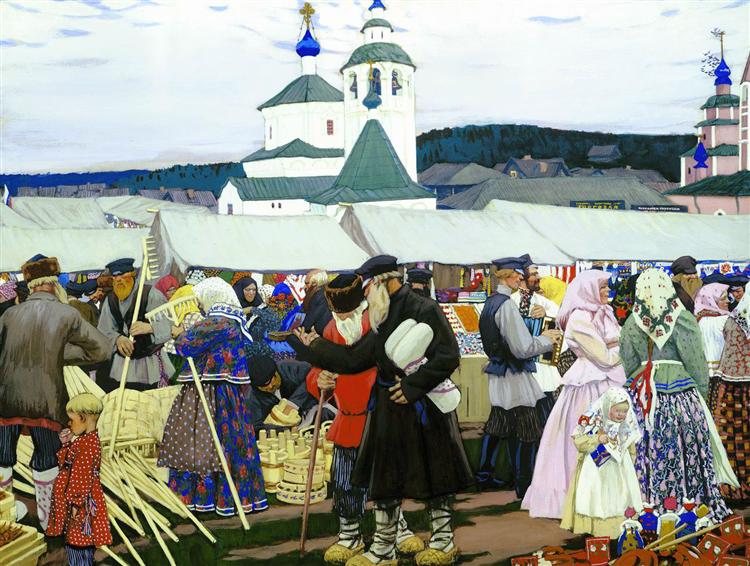Kustodiev Boris – “Fair”
The painting “Fair” was painted by Boris Kustodiev in 1906 by order of the Expedition of Procurement of State Papers, which intended to publish a series of reproductions of modern paintings for the people, made in the spirit of popular prints. For Kustodiev, the order turned out to be a happy occasion, as it stimulated his own search for festively colorful painting. They bought and sold at fairs, talked, played, had fun. Such a fair – a holiday for all villagers – was portrayed by Boris Kustodiev in his painting.
The artist conveyed the motley, multi-colored spectacle of the fairground bustle, using clean, bright colorful spots and a composition, as if cut off at the edges and snatching out a fragment of the crowd, part of the flow of people. They move in different directions along the line of trays. There are no clearly defined main characters and any single common action, everyone is busy with their own: the little boy on the left – whistles, the ruddy, doll-like girl on the right – looking at dolls, a woman in a flowered chintz dress – choosing a rake, a guy in a cap, accompanied by a friend, – an accordion, an old man in bast shoes, who bought new felt boots, – a sedate conversation on the go with another, leaning on a stick.
The artist did not show the faces of the fair participants: they are perceived as one whole. The eyes are full of flickering festive clothes: elegant dresses of women, bright shawls, new bast shoes and men’s caftans. In the foreground, Kustodiev depicted two elderly men who are furiously arguing about something: maybe they are bargaining about something, maybe they are discussing previous fairs. Nearby is a boy chewing sugar and a girl holding a new doll in her hands. Two women stand at the counter and discuss the goods, others try on patterned scarves. In another part of the picture, buyers choose the things they need on the farm: shovels, rakes, buckets. It is noticeable how the woman is bargaining with the seller. Nearby, young guys want to buy some musical instrument. The accordion attracts them the most – they experience its sound. Bright colors, vigorous activity – the fair is boiling, having fun, consulting, bargaining, discussing goods and the latest news.
In the background of the painting, Boris Kustodiev depicted a village. It is executed in completely different colors – gray houses, gray low sky. After the end of the fair day, people will have to return to their everyday gray life and look forward to a new bright fair.
Above all this spectacle, white and pink, with green roofs, churches and bell towers rise, at the foot of which a bargaining took place. The space at Kustodiev is thickened to the limit with figures and images of fairground goods, the composition is built in stripes, tiers – such are the images of the crowd, canvas awnings over the trays, strips of distant forest and the sky whitish from clouds. Color is not subject to “naturalness”, does not depend on the conditions of changing natural lighting, and although the artist conveys subtle colorful nuances inside its spots, on the whole the color is “stacked” into clear generalized lines of silhouettes that simplify and flatten the form. The fragmentation of the composition, the brightness of the color, the flattening of the volumes – everything in the picture is “built” and not “copied from nature”, everything is subordinated to the conventions of the image, the solution of decorative artistic tasks, the expressive characteristics of the types of the fair audience. Already in this picture – the first in the fair series – a number of the main features of the uniquely individual style of Kustodiev’s everyday paintings were outlined, but these features, however, were not immediately and not fully realized by him as an important find. The search for decorativeness led the artist to a certain variegation of color, which he sought to remove, softening its excessive harshness due to the general harmonization of colorful spots, their relationship with each other on the plane of the picture. In portraits, where Kustodiev relied on the traditions of plein air and used a darkened and narrowed color range, he successfully achieved a general tone. This task was not here, and past experience could not help. On a new path, new difficulties arose for the artist in overcoming the shortcomings of the color system. Alexander Benois once called Kustodiev’s specificity “a fight of colors”. Kustodiev, however, believed that variegation is inherent in Russian life itself, is its characteristic quality, and in the future did not abandon color intensity in his canvases, continuing his search for a kind of “harmonious variegation”. The sharp individuality of Kustodiev’s handwriting in the Yarmarka impressed the members of the Tretyakov Gallery Council, and the painting was bought for this museum.
Year of painting: 1906.
Dimensions of the painting: 66.5 x 88.5 cm.
Material: canvas.
Writing technique: oil.
Genre: genre painting.
Style: modern.
Gallery: State Tretyakov Gallery, Moscow, Russia.
